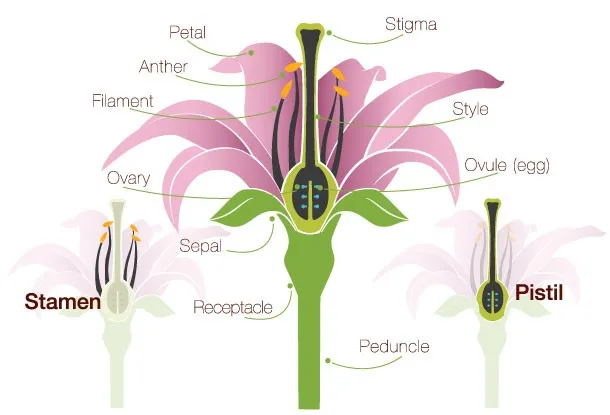The Flower Anatomy: The Parts of a Flower

Get out your scratch pad – it's the ideal opportunity for a lesson in blossom life systems! The greater part of us think about petals and stems, yet for you with inquisitive personalities, here's a more careful once-over of what makes a blossom a bloom.
1.Petal:-
Petals are what give a blossom its special shape, and are frequently brilliantly shaded to draw in creepy crawlies and critters, which unwittingly help in the treatment of ovules through fertilization.
2.Sepal:-
These are the little, leaf-like parts developing at the base of the petals. They serve to ensure the bloom before it blooms.
3.Peduncle:-
This alludes to the stem or stalk of a bloom.
4.Repository:-
This is the thickened part at the base of the bloom which holds its real organs.

5.Pistil-
This is the female organ of the blossom. It comprises of four noteworthy parts:
Shame – The leader of the pistil. The disgrace gets dust, which will start the procedure of preparation.
Style – This is the name for the stalk of the pistil. At the point when dust achieves the shame, it starts to grow a tube through the style called a dust tube, which will in the end achieve the ovary. The style thusly goes about as a support against dust pollution, since just perfect dust can grow a dust tube.
Ovary – The base of the pistil. This organ holds the ovules anticipating treatment.
Ovules – These are the bloom's eggs, situated inside the ovary. Upon treatment by dust, they will in the long run develop into a seed. In organic product plants, dust won't just start the development of a seed, however an encompassing natural product also.
6.Stamen:-
This is the male organ of the blossom, comprising of two noteworthy parts:
Anther – The leader of the stamen. The anther is in charge of the creation of dust, which will ideally be transported to the pistil by creatures or creepy crawlies, for example, honey bees. This is a pivotal piece of the multiplication of the plant.
Fiber – This is the stalk that holds the anther and connects it to the blossom.
7.Making More Flowers:-
It's astonishing for nature to furnish a blossom with the capacity to replicate without the requirement for a mate, however not every one of them do!
A few blossoms have just male or female organs, and require a different bloom of the inverse sex to repeat. We call these Imperfect Flowers. Idealize Flowers, then again, have both a stamen and a pistil, and can recreate alone.